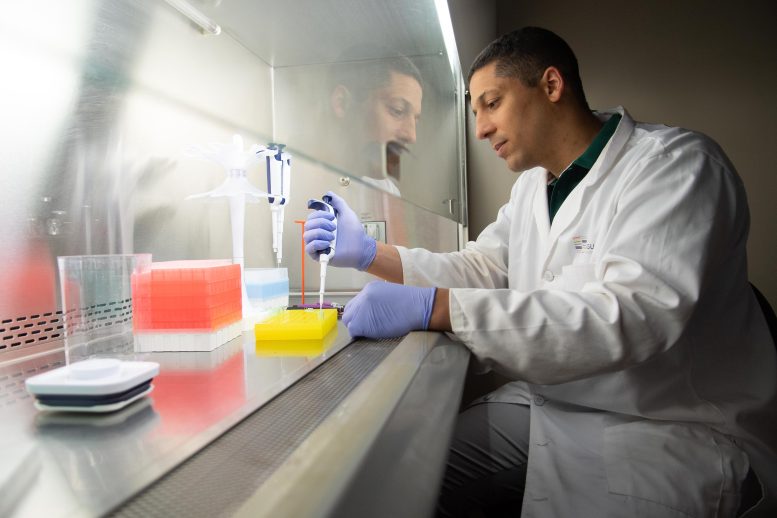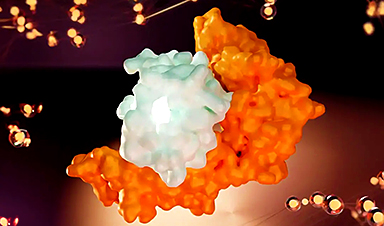New study shows that common genetic variation among people is responsible for mediating SARS-CoV-2 asymptomatic infection.
Have you ever wondered why some people never became sick from COVID-19? A study published recently in the journal Nature shows that common genetic variation among people is responsible for mediating SARS-CoV-2 asymptomatic infection. The results indicate that individuals having this variant never feel sick once infected. This exciting discovery was a result of a U.S.-Australia collaborative work led by Danillo Augusto, Ph.D., assistant professor at the University of North Carolina at Charlotte; Jill Hollenbach, Ph.D., professor at the University of California San Francisco; and Stephanie Gras, professor at La Trobe University in Australia.
The Role of Human Leukocyte Antigens (HLA)
The study focuses on a group of genes called human leukocyte antigens (HLA). These HLA genes code for proteins used by the immune system to identify your healthy cells and distinguish them from those infected by bacteria and viruses. The HLA system is critical for immune response and also highly variable among individuals. Because of the role of HLAs in fighting infection, the researchers wondered if there were specific variants that would make us more protected or susceptible to SARS-CoV-2 virus.

Danillo Augusto, assistant professor of Biological Sciences at UNC Charlotte. Credit: UNC Charlotte
Research Findings and Methodology
Hollenbach led the data collection, which started at the beginning of the pandemic. First, 29,947 unvaccinated individuals were screened using a mobile app designed specifically to track COVID-19 symptoms, and 1,428 reported a positive test for the virus. All individuals had their DNA previously sequenced to analyze their HLA genes. The researchers found that individuals having the genetic variant HLA-B*15:01 were much more likely to remain asymptomatic after infection. Impressively, this variant is present in about 10% of the population. In summary, individuals who had HLA-B*1501 in their genome could not dodge the infection, however, they escaped being sick.
Insights on Immune Response
“We hypothesized that their immune system could react so fast and powerfully that the virus was eliminated before causing any symptoms. It’s like having an army that already knows what to look for and can tell by the uniform that these are the bad guys,” according to Hollenbach.
HLA molecules display pieces of the virus to immune effector cells for inspection. The study used cells from individuals with HLA-B*15:01 who donated blood several years before the pandemic. The results showed that those individuals had memory T cells against a specific particle of SARS-CoV-2. Individuals who never had any contact with SARS-CoV-2 had already had some kind of previous exposure to other viruses and developed immunological memory against a particle from SARS-CoV-2.
Their immunological memory would elicit a much faster response and explain why those individuals remained asymptomatic. Still, it remained intriguing how they could develop immunological memory against SARS-CoV-2 without ever being exposed to this virus.
Cross-Reactive Immunological Responses
“It is widely known that other types of coronaviruses have caused seasonal colds for decades. We hypothesized that these individuals were exposed to seasonal coronaviruses in the past, and somehow, individuals specifically carrying HLA-B*15:01 could quickly kill cells infected by SARS-CoV-2 due to cross-reactive immunological responses. So, even if the bad guys changed the uniform, the army would still be able to identify them by their boots or maybe a tattoo on their arms. That is how our immunological memory works to keep us healthy,” said Augusto.
After carefully analyzing the genomic sequences of all coronaviruses, the study showed that this SARS-CoV-2 particle recognized by HLA-B*15:01 in unexposed individuals is very similar to viral particles from other previous coronaviruses. The research demonstrated that T cells from pre-pandemic individuals could identify viral particles from past coronaviruses and SARS-CoV-2 with the same efficiency by showing crystal structures and affinity assays. It means those individuals created immunological memory for the previous coronaviruses, but because of the high similarity of this viral particle, their memory T cells can also recognize and kill SARS-CoV-2 very fast.
Implications and Future Research
The results show a mechanism for how individuals can avoid being sick from SARS-CoV-2 and the research group plans to continue learning about the response against this virus, which will result in better understanding of COVID-19 therapeutics and vaccines.
For more on this research, see Unmasking the Secret of COVID-19 “Super Dodgers.”
Reference: “A common allele of HLA is associated with asymptomatic SARS-CoV-2 infection” by Danillo G. Augusto, Lawton D. Murdolo, Demetra S. M. Chatzileontiadou, Joseph J. Sabatino Jr, Tasneem Yusufali, Noah D. Peyser, Xochitl Butcher, Kerry Kizer, Karoline Guthrie, Victoria W. Murray, Vivian Pae, Sannidhi Sarvadhavabhatla, Fiona Beltran, Gurjot S. Gill, Kara L. Lynch, Cassandra Yun, Colin T. Maguire, Michael J. Peluso, Rebecca Hoh, Timothy J. Henrich, Steven G. Deeks, Michelle Davidson, Scott Lu, Sarah A. Goldberg, J. Daniel Kelly, Jeffrey N. Martin, Cynthia A. Vierra-Green, Stephen R. Spellman, David J. Langton, Michael J. Dewar-Oldis, Corey Smith, Peter J. Barnard, Sulggi Lee, Gregory M. Marcus, Jeffrey E. Olgin, Mark J. Pletcher, Martin Maiers, Stephanie Gras and Jill A. Hollenbach, 19 July 2023, Nature.
DOI: 10.1038/s41586-023-06331-x
News
Studies detail high rates of long COVID among healthcare, dental workers
Researchers have estimated approximately 8% of Americas have ever experienced long COVID, or lasting symptoms, following an acute COVID-19 infection. Now two recent international studies suggest that the percentage is much higher among healthcare workers [...]
Melting Arctic Ice May Unleash Ancient Deadly Diseases, Scientists Warn
Melting Arctic ice increases human and animal interactions, raising the risk of infectious disease spread. Researchers urge early intervention and surveillance. Climate change is opening new pathways for the spread of infectious diseases such [...]
Scientists May Have Found a Secret Weapon To Stop Pancreatic Cancer Before It Starts
Researchers at Cold Spring Harbor Laboratory have found that blocking the FGFR2 and EGFR genes can stop early-stage pancreatic cancer from progressing, offering a promising path toward prevention. Pancreatic cancer is expected to become [...]
Breakthrough Drug Restores Vision: Researchers Successfully Reverse Retinal Damage
Blocking the PROX1 protein allowed KAIST researchers to regenerate damaged retinas and restore vision in mice. Vision is one of the most important human senses, yet more than 300 million people around the world are at [...]
Differentiating cancerous and healthy cells through motion analysis
Researchers from Tokyo Metropolitan University have found that the motion of unlabeled cells can be used to tell whether they are cancerous or healthy. They observed malignant fibrosarcoma cells and [...]
This Tiny Cellular Gate Could Be the Key to Curing Cancer – And Regrowing Hair
After more than five decades of mystery, scientists have finally unveiled the detailed structure and function of a long-theorized molecular machine in our mitochondria — the mitochondrial pyruvate carrier. This microscopic gatekeeper controls how [...]
Unlocking Vision’s Secrets: Researchers Reveal 3D Structure of Key Eye Protein
Researchers have uncovered the 3D structure of RBP3, a key protein in vision, revealing how it transports retinoids and fatty acids and how its dysfunction may lead to retinal diseases. Proteins play a critical [...]
5 Key Facts About Nanoplastics and How They Affect the Human Body
Nanoplastics are typically defined as plastic particles smaller than 1000 nanometers. These particles are increasingly being detected in human tissues: they can bypass biological barriers, accumulate in organs, and may influence health in ways [...]
Measles Is Back: Doctors Warn of Dangerous Surge Across the U.S.
Parents are encouraged to contact their pediatrician if their child has been exposed to measles or is showing symptoms. Pediatric infectious disease experts are emphasizing the critical importance of measles vaccination, as the highly [...]
AI at the Speed of Light: How Silicon Photonics Are Reinventing Hardware
A cutting-edge AI acceleration platform powered by light rather than electricity could revolutionize how AI is trained and deployed. Using photonic integrated circuits made from advanced III-V semiconductors, researchers have developed a system that vastly [...]
A Grain of Brain, 523 Million Synapses, Most Complicated Neuroscience Experiment Ever Attempted
A team of over 150 scientists has achieved what once seemed impossible: a complete wiring and activity map of a tiny section of a mammalian brain. This feat, part of the MICrONS Project, rivals [...]
The Secret “Radar” Bacteria Use To Outsmart Their Enemies
A chemical radar allows bacteria to sense and eliminate predators. Investigating how microorganisms communicate deepens our understanding of the complex ecological interactions that shape our environment is an area of key focus for the [...]
Psychologists explore ethical issues associated with human-AI relationships
It's becoming increasingly commonplace for people to develop intimate, long-term relationships with artificial intelligence (AI) technologies. At their extreme, people have "married" their AI companions in non-legally binding ceremonies, and at least two people [...]
When You Lose Weight, Where Does It Actually Go?
Most health professionals lack a clear understanding of how body fat is lost, often subscribing to misconceptions like fat converting to energy or muscle. The truth is, fat is actually broken down into carbon [...]
How Everyday Plastics Quietly Turn Into DNA-Damaging Nanoparticles
The same unique structure that makes plastic so versatile also makes it susceptible to breaking down into harmful micro- and nanoscale particles. The world is saturated with trillions of microscopic and nanoscopic plastic particles, some smaller [...]
AI Outperforms Physicians in Real-World Urgent Care Decisions, Study Finds
The study, conducted at the virtual urgent care clinic Cedars-Sinai Connect in LA, compared recommendations given in about 500 visits of adult patients with relatively common symptoms – respiratory, urinary, eye, vaginal and dental. [...]





















